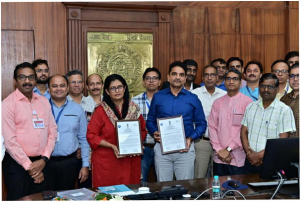Deployment of 10 numbers of Water Purification Units (750/500 LPH Capacity) in Railway Platforms (CSMT/LTT/Dadar Station/Dockyard Road Station), Mumbai Division, Central Railway

Deployment of 10 numbers of Water Purification Units (750/500 LPH Capacity) in Railway Platforms (CSMT/LTT/Dadar Station/Dockyard Road Station), Mumbai Division, Central Railway
Bhabha Atomic Research Centre (BARC), of Department of Atomic Energy (DAE) has developed unique, cost-effective, and place-and-case-specific membrane-based technologies for treatment of ground/surface water with respect to removal of suspended solids, microbial contamination, arsenic, iron, fluoride, heavy metals, nitrate and salinity etc., at domestic as well as at community-scale.
As a part of technology demonstration, while providing safe drinking water to the common masses, BARC has conceived a Project on deployment of water technologies in several parts of India. Under this Project, 10 Nos. of 750/500 LPH capacity BARC technology-based water purification units are installed & commissioned by M/s Osmotech Membranes Pvt. Ltd, Rajkot (BARC technology licensee) – 3 units of 750 LPH capacity at CSMT, Mumbai; 4 units of 500 LPH capacity at LTT, Mumbai; 2 units of 500 LPH capacity at Dadar Station, Mumbai & 1 unit of 750 LPH capacity at Dockyard Road Station, Mumbai, as a pilot project.
As per the Memorandum of Agreement (MoA) dated 6th January, 2023 signed between BARC, Mumbai and Mumbai Division, Central Railway (Mumbai), ten units are now handed over to Central Railway on 27th January, 2024 for use by the passengers. Regular maintenance of the units for next one year, as per the MoA, shall be carried out by BARC technology licensee with necessary site support being extended by Central Railway, as and when required.
The salient features of these installed water purification units are as follows:
• Heart of the device: Ultrafiltration (UF) membrane rolled in spiral configuration (having very high membrane packing density).
• Working principle: It works on the size-exclusion principle of UF membrane and needs no addition of any chemicals. The unit does not require any operator for day to day operation and regular cleaning of pre-treatment section & membrane modules.The device has features to offer cold and normal water through push-button dispensing (auto dispensation).
• Quality: It is capable of removing micro organisms (> 99.99%), suspended solids, colloids, and high molecular weight organics (> 50 kDa), thereby producing crystal-clear water complying with BIS 10500.
• Modularity: Highly compact and modular in nature. With the given dimension of the presently installed enclosure (8 ft L x 7 ft Wx 8 ft H), UF membrane modules that can offer up to 1000 LPH of safe drinking water can be installed.
• Uniqueness:
A) As the device physically filters out bacteria and suspended solids, there will not be any dead or decayed bodies of bacteria in purified water, unlike UV- and/or chemical addition/adsorption-based water purifiers.
B) It does not remove ions/minerals present in water and hence the minerals in raw water remain intact.
• Minimal/zero wastage offeed (raw) water: More than 95% of feed is recovered as product water.
• Affordability: Typical cost of the unit of 750 LPH capacity housed in an aluminium composite panel is Rs. 5, 00, 000/- (Rupees five lakhs).
• Life: The life of the unit is 10 years, with the life of membrane e varying from 3-5 years, based on the raw water turbidity.
• Minimal maintenance: Maintenance cost does not involve any operator cost. Electricity consumption would be –3.0kW.h (for 750 LPH water consumption, considering 2/3rd consumption due to chiller usage). Membrane replacement cost will be Rs. 30,000/- every 3-5 years.
In this context, Director BARC Shri Vivek Bhasin, informed that BARC has developed several site- and case-specific, robust desalination and water purification technologies, as a spin off to the R&D in nuclear technology. They can address the prevalent ground water contaminants like fluoride, arsenic, iron, heavy metals, salinity etc., while offering safe drinking water to the common masses. Details of these technologies can be accessed at vvww.barc. gov. in/technologies.
Secretary, DAE Dr. Ajit Kumar Mohanty mentioned that in alignment with Jal Jeevan Mission launched by the Government of India, DAE has deployed the brackish & seawater desalination as well as point-of-use water purification technologies in rural, remote, and strategic locations of India. He emphasized upon the need for the adoption of these BARC-developed know-how by many more entrepreneurs for its wider dissemination &commercial deployment.

Picture of 750 LPH capacity water purification unit installed at PF-14/15, CSMT, Mumbai


